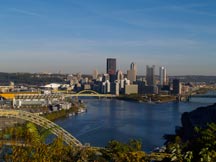
Quarantined Pittsburgh
March 30, 2020
Boost Your Immune System
April 27, 2020
Back in the day, people used to take a Sunday drive to relax and get a change of scenery. If you are looking to expand your horizon, below are some driving tours that you can take to explore the area. Some are confined to city while others involve a bit more time in the car. With the help of GPS, you can simply search for the sites online and find the best route that suits you.
Breathtaking Views of Pittsburgh Tour
Everybody goes to the Mt. Washington Overlooks for a view of city for a reason: the vista is simply breathtaking. However, once you're done there, we recommend hitting some of these other spots for a different—yet, just as gorgeous—perspective of the city. The Southside Slopes offer exemplary views of the Monongahela River from several spots along the mountainside. The West End Bridge provides a spectacular view of The Point and all three rivers. Entering the city via the Ft. Pitt Tunnels provides a dazzling sight. As travelers emerge from the dark tunnel, they are greeted with a shining city scape no matter the time of day. Across the city, on the North Side is the Cotoma Street Overlook in Fineview. This spot gives an up-close and personal view of the Allegheny River-side of the city.
Mt. Washington, West End Bridge, Exiting the Ft. Pitt Tunnel inbound), Fine View, Southside Slopes

West End Overlook
Catholic Shrines of Pittsburgh Tour
St. Patrick in the Strip District contains a replica of the Holy Stairs Jesus is believed to have ascended to be judged by Pontius Pilate. Also, in the Strip, St. Stanislaus was built by the area’s Polish community and was visited by Saint John Paul II. On nearby Troy Hill is St. Anthony Chapel, which has the world’s largest collection of relics outside of the Vatican. Not far from there is St. Nicholas in Millvale, which boasts the Maxo Vanka murals of Croatian immigration and the destruction of Europe in World War II. On Polish Hill is Immaculate Heart of Mary, which is modeled after St. Peter’s in Rome and was also built by Polish immigrants.
The South Side Slopes boast a unique walking tour known as the Church Route. This route traverses city steps, goes by beautiful views of the city, and takes you past eccentric hillside architecture and historic churches. A map of the Church Route can be found on the South Side Slopes Neighborhood Association's website.
St. Patrick, St. Stanislaus Kostka, St. Anthoy Chapel, St. Nicholas, Immaculate Heart of Mary, Strip District, South Side Slopes, Troy Hill, Millvale, Polish Hill
Historic Military Forts Tour
We have three surviving forts in Western Pennsylvania. In downtown Pittsburgh we have Fort Pitt and the Block House in Point State Park. If you know your local history, you know that Fort Duquesne stood in the same spot until the French destroyed it and retreated, thus allowing the British to build Fort Pitt. About a 90-minute drive east of Pittsburgh is Ligonier, PA. Fort Ligonier was a British fortification built during the Seven Years War (aka French & Indian War). Fort Bedford is about an hour further southeast, and was built around the same time. The original fort was demolished, but in 1958, a log blockhouse was erected to commemorate the fort’s 200th anniversary.
Fort Pitt (& Fort Duquesne), Fort Ligonier, Fort Bedford
Industrial Plant Tour
Not long ago, our river banks were lined by nearly three dozen industrial plants. After the collapse of the steel industry in the 1980s, most mills in the area were shuttered. The Homestead Stacks and the Carrie Blast Furnaces are two rare remnants of Pittsburgh’s manufacturing past. The Carrie Blast Furnaces in Rankin have been preserved as the only non-operative blast furnaces remaining in the area.
The Waterfront in Homestead, now an entertainment, shopping and dining destination, was once home to U.S. Steel’s Homestead Works. Today, you can see the towering stacks that have been left to commemorate the area’s steelmaking past. Built in WWII, the stacks are all that remain of the 45-inch Plate Mill. These stacks were venting stacks and not “smokestacks” as they are sometimes referred to. They were a part of the soaking pits. Inside the soaking pits, the temperature would reach 2250° Fahrenheit, and the venting stacks helped to equalize the internal and external temperatures of the steel ingots before they were sent to the rolling mill.
Carrie Blast Furnaces, Homestead Stack

Homestead Stacks
Golden Age Mansions Tour
During the Golden Age (approximately 1830 through 1930), Pittsburgh was home to more millionaires than New York City. Many of them settled in the east end of Pittsburgh in Point Breeze, Shadyside, and Squirrel Hill. Located on Fifth Avenue in Shadyside, the Mansions on Fifth Hotel was formerly the home of prominent attorney Willis McCook. The Point Breeze estate of Henry Clay Frick is now a museum. South Penn Oil Company executive, John Worthington, built his mansion in Squirrel Hill. Today it is the Temple Sinai synagogue. The Mellon estate in Shadyside was once the largest home in Pittsburgh. Though it was destroyed during World War II, the land is now home to Mellon Park.
East End Mansions, Frick Musuem, Mellon Park
Millionaires' Row
The Ridge Avenue area near the North Side campus of Community College of Allegheny County was once known as Millionaires’ Row. It includes the mansions of Pittsburgh writers, Gertrude Stein and Mary Roberts Rinehart, and the homes of other wealthy industrialists like Henry W. Oliver and William Penn Snyder.
North Side, Allegheny West
Historic Homes Tour
Located in South Park, the Oliver Miller Homestead is the site of the first shots of the Whiskey Rebellion. The Walker-Ewing Log House, located in Collier Township, was built in the late 1700s. Fulton Log House in Upper St. Clair was built around 1830 by Alexander Gilfillan and later came to be owned by the Fulton family. The Neill Log House is the oldest home in Pittsburgh and is located in Schenley Park. It was built in 1765.
Oliver Miller Homestead, Pittsburgh Log Houses
Sports Tour
Before there was PNC Park and Three Rivers Stadium, there was Forbes Field in Oakland. Today, you can visit what remains of the ballyard—the outfield wall—in Oakland. Honus Wagner was one of the best Pirates to ever play the game. His childhood home is in Carnegie on Beechwood Avenue. Donora is home to two stars of the baseball diamond—Stan Musial and Ken Griffey Senior. Musial grew up on 465 Sixth Street, and Griffey on Marelda Avenue.
Forbes Field outfield wall, Honus Wagner House, Stan Musial & Ken Griffey's Hometown

Forbes Field Wall
The Harmonist Society Tour
The Harmony Society was founded by George Rapp in the 1780s in Germany. This Christian Separatist group left Europe and established two settlements in Western Pennsylvania. The first, the quaint town of Harmony in Butler County and the second, Old Economy in Ambridge, Beaver County.
Harmony, PA; Old Economy




